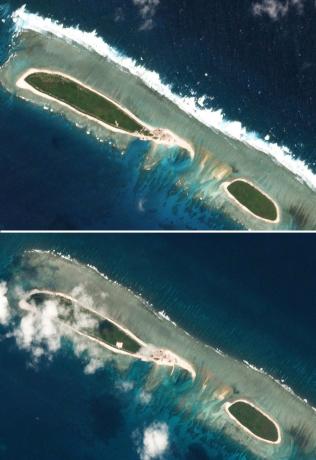
A series of new satellite images showed that China has started fresh construction work in the disputed waters of South China Sea. These latest images are a sign of Beijing's continuous move to strengthen its military reach across the vital trade waterway.
Although, China is seeking to avoid a fresh confrontation with the new administration of U.S. President Donald Trump, but experts believe that the construction work shows Beijing's determination to build up its network of reefs and islets.
An image of North Island in the Paracels group taken on March 6 shows recent work including land clearing and possible preparation for a harbour to support what experts believe may be eventual military installations. However, the initial work was severely damaged in a typhoon in 2016.
Planet Labs, a private satellite firm provided the pictures that follow reports in January showing work undertaken on nearby Tree Island and other features in the Paracels, which are also claimed by Vietnam and Taiwan.
According to diplomats, who were briefed on latest Western intelligence assessments, China is pursuing efforts to dominate its maritime 'backyard', even if it tweaks the timing of moves to avoid being overtly provocative.
"The Paracels are going to be vital to any future Chinese attempt to dominate the South China Sea," Carl Thayer, a South China Sea expert at Australia's Defence Force Academy told Reuters.
"We can see they are committed to militarisation, whatever the official rhetoric tells us, even if they are going to do it bit by bit," Thayer added.
The authorities say that the Spratlys archipelago, which are more widely disputed are high profile, but the Paracels are key to China's presence in the South China Sea.
In recent years, China has temporarily based surface-to-air missile launchers and crack jet fighters at long established bases on Woody Island on the Paracels. It has also helped in protecting its nuclear submarine facilities on Hainan Island.
North Island is part of an arc of reefs, which are expected to form a protective screen for Woody. The island also includes civilian facilities and a listening post.
Zhang Baohui, a mainland security expert at Hong Kong's Lingnan University, said he believed that China was pursuing long-held goals of strengthening its facilities in the Paracels. He added that he had thought the Trump administration would not over-react given other pressing priorities.
"There's also uncertainty with this young Trump administration, but this is very important work to the Chinese...the Paracels are vital to defending Hainan, which is in turn important to China's nuclear deterrent," Baohui said. "The calculation here is that it is really only Vietnam that will be rattled by this."
Ministry responses
When contacted for further information, the Vietnamese Foreign Ministry did not immediately respond to requests for comment.
Meanwhile, China's Defence Ministry said it was "not familiar" with any work at North Island. "What needs to be stressed is that the Xisha Islands are China's inherent territory," the ministry said, using the Chinese name for the Paracels.
In 1974, China had fully occupied the Paracels after forcing the navy of the-then South Vietnam off its holdings.
The news of fresh Chinese activities in the disputed waterway comes as Rex Tillerson prepares for his first visit to the region as U.S. Secretary of State later this week. In January, Tillerson had said that China should not be allowed access to islands it has built in the South China Sea.
A U.S. official, who spoke on the condition of anonymity, could not confirm the new construction work on North Island. But he said that it would not be surprising.
"It would be in line with what they have been doing, why else would they clearing land on the islands but for militarisation," the official said. "There is no other reason to have a presence there."
When questioned about the work, Beijing's diplomatic sources said that China is not looking for confrontation with the United States over the South China Sea. It pointed to Beijing's low-key reaction to last month's patrol of a U.S. aircraft carrier strike group in the waters there.
Recently, China has sought to portray itself as being conciliatory over the disputed waterway. It said that Beijing and other Southeast Asian nations are committed to a peaceful resolution.
Last week, the Chinese Foreign Minister Wang Yi said that a draft code of conduct for behavior in the South China Sea has been completed. He also added that the tensions had "distinctly dropped" at present.








